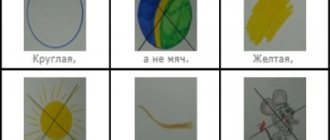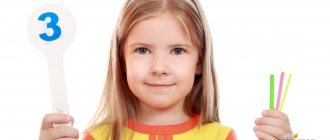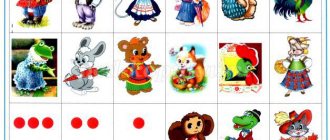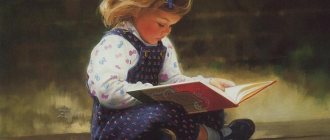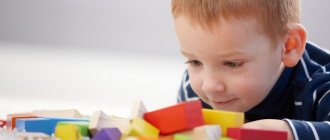Article:
Scientists have proven that geniuses are not born, they are made. Becoming a genius in your child is a long and not easy process. The early period of development requires a lot of time, attention, and love. You can’t do without knowledge of techniques. The “Colored Numbers” technique, developed at the beginning of the 20th century by the teacher and scientist from Belgium George Cuisenaire, is a help to all mothers and early childhood educators. His ideas are consistent with the concept of early development, which was put forward by the Russian teacher innovator B.P. Nikitin.
Methodology
What new will the child learn, what skills will the Cuisenaire rods develop in him? Here is a small list of what a child can do thanks to them:
- quickly learn colors;
- will understand the concepts of “short”, “long”, “high”, “low”;
- will develop fine motor skills, thinking, imagination;
- will get an idea of the categories “part”, “whole”, “more”, “less”;
- master construction using a logical approach;
- solve your first mathematical examples, mathematics will become an exciting science.
A little history
The manual attracts children not only with its versatility, but also with its bright design.
A mathematical manual (1952) by the Belgian mathematician George Cuisenaire is based on the visual-tactile mastery of abstract concepts such as set, order and identity. By the way, we owe the popularization of the manual to Cuisenaire’s colleague, the French mathematician and philosopher Caleb Gatenot, who began to use the “numbers in color” manual (“counting sticks”, “colored rulers”, “colored sticks”, “Cuisenaire sticks”) when studying mathematics and language.
Description of the kit
Cuisenaire sticks are a set of 116 sticks of different colors and lengths. Total 10 colors: white, pink, blue, red, yellow, purple, black, burgundy, blue, orange.
Each color corresponds to a length. The white stick is the shortest, it is a cube 1 cm long, the orange one is the longest - 10 cm.
The table shows that all colors form three families + white, black (neutral) colors. Orange and purple are present in two families, as they appeared due to the mixing of these colors.
In addition, the numbers encrypted in the red family are divisible by two, in the blue family by three, and in the yellow family by five.
| Red family | Blue family | Yellow family |
| Pink | Blue | Yellow |
| Red | Blue | Orange |
| Burgundy | Violet | |
| Orange | ||
| Violet |
In addition to the Cuisenaire counting sticks themselves, the set contains mathematical signs for basic operations, as well as numbers from 1 to 20. For children who have already mastered “color counting”, classic examples can be used, like at school. Also included are instructions for use.
The material used for the “color count” is lightweight, smooth, and made from certified plastic. They are excellent counting material. Cardboard numbers and signs. This workbook helps you do addition, subtraction, multiplication, and division.
How to make sticks with your own hands
Buying a set is easier than making it, but parents do not always have this opportunity. Store-bought bars are bulky, but making them at home is very difficult. It’s easier to make flat ones for the baby. Instructions:
Prepare 10 sheets of colored cardboard. The shades must correspond to those listed in the previously presented table.
The strip sizes will be doubled. Width 2 cm, length – 2, 4, 6, 8, 10, 12, 14, 16, 18.20 cm.
Mark the colored sheets by drawing rulers in the quantity you need.
Cut the cardboard into colorful strips with sharp scissors.
Purposes of use
There are parents who are afraid that it is too early to load their child with mathematics. Educators agree that it is better to worry about it not being too late. Sensitive periods in development do not last so long; we cannot know for sure about their timing. They pass very quickly; will the child have time to master the necessary skill during this period? Therefore, it is better to offer your child tasks in his zone of proximal development. It may be difficult for now, but when his brain is ready, he will cope with the task, to the surprise of you and those around him.
Here are the main reasons why teachers all over the world actively use Cuisenaire colored counting sticks in their teaching practice:
- Using the clarity of mathematical operations, which allows you to work with young children.
- Development of fantasy and imagination. The number of tasks with this tool tends to infinity.
- Fine motor skills develop, as the fingers are involved in the work.
- Science turns into an exciting game, which means it is easier for children to perceive and assimilate. Oral counting is easy.
- Helps in developing related skills and teaching writing. You can build with them like a construction set, lay out words, and assemble labyrinths.
- Allows you to measure the lengths of other objects, since the length of each color module in centimeters is known in advance.
- Makes it possible to consolidate the understanding of geometric shapes by drawing up their contours.
- Forms a sustainable interest in knowledge, including mathematical science.
Price of Cuisenaire sticks
Store-bought kits are inexpensive, but working with them is much more convenient. They can always be ordered from the online store with home delivery. Flat ones, made at home, have one advantage - low price, but with them many tasks are impossible to complete. For the approximate cost at which you can buy cuiseneur sticks, see the table below:
| Name of product | Approximate price in rubles |
| Cuisenaire set and 2 game albums for children 2-5 years old | 580 |
| Cuisenaire set and 2 game albums for children 3-8 years old | 780 |
| Set of 116 pcs. | 325-415 |
From what age
Cuisenaire sticks, as well as Dienesh blocks, can be used even earlier than indicated on the box. The author himself suggested starting classes from 1 year. Experienced teachers recommend starting classes at the age of 2, under the mandatory supervision of parents. In fact, without their participation, the educational and gaming process will not work. As the child grows up, gaming tasks become more complex.
The largest number of tasks is provided for ages 3–4 years. Middle age, preschoolers (5-6 years old) are capable of solving more serious educational problems. Even older children, primary school students (7-9 years old) find these activities interesting.
Advantages and disadvantages
There are many positive aspects, below are some of them:
- There are many options on how to develop fine motor skills, thinking, and imagination;
- Formation of conscious attention, perseverance;
- Memory training, reactions;
- The ability to use one teaching material for children of different age groups, changing only the wording of the tasks themselves;
- Children acquire the skill of finding solutions independently.
Scientists could not find any disadvantages as such. Some sources indicate that the disadvantage is the need for the presence of an adult, since when playing independently, children quickly lose interest in such a game. We can say that all upbringing and training requires the participation of adults, so this minus should not be taken into account.
To achieve maximum results, you need to work with your child systematically. Proper encouragement and a variety of activities will also help in quickly mastering the basics of mathematics.
Similarities and differences with Dienes blocks
Often, Cuisenaire sticks and Dienesh blocks stand side by side among early development techniques. This is no coincidence; they are somewhat similar. Both methods use visual and effective material, train logical thinking, and develop imagination. They are multifunctional, aimed at children of different ages, and easy to learn.
The difference between Dienesh blocks is the additional parameter of differences in materials in thickness (thin and thick) and in shape (circle, triangle, square). In Cuisenaire's colored rods there is a difference in length in centimeters, as well as a larger number of colors. They have the opportunity to create examples from numbers using mathematical symbols, illustrating them with examples of “color counting”.
Dienesh blocks and Cuisenaire sticks are techniques that represent demonstration material; they do not contradict each other, but complement each other perfectly. You can use these two sets together. This will allow you to further diversify your classes by coming up with new and interesting tasks. An innovative approach to education calls for teaching through play so that information is remembered easily and naturally.
Schemes for Cuisenaire sticks
You will be able to find a huge number of drawings on sale. There are diagrams online that can be printed in the desired format. They need to be filled completely or partially with multi-colored blocks. You can also repeat the drawing on another surface, and then compare the shapes. Schemes can be black and white or colored. Classes on them develop children's logical and creative thinking, counting skills, and color representation. There are even schemes by which you can create three-dimensional plot drawings and even entire fragments from fairy tales.
Games
For children in kindergarten, preschoolers and schoolchildren, various games with Cuisenaire sticks have been developed, from the simplest to the more complex.
Games for kids 1 – 2 years old
Children can only work with this manual under adult supervision, as there are small parts. Home comfort and familiar surroundings contribute to the development of new activities. Already at one year old, children can play with them, look at colors, and the adult’s task is to give comments about length, color, height, quantity.
"Builder". Invite your child to look at the building materials, take as many blocks as possible in one hand, then transfer them to the other. So the child's hand will begin to feel the difference in size and quantity. Build a road, house, bridge, tree, well, transport with your child.
"Sorter." You can take colored cardboard and invite your child to sort the sticks by color. You need to put all the red ones on the red sheet, and all the yellow ones on the yellow sheet.
"Up the stairs." Assemble the ladder from the white to the yellow stick. Take a small toy, such as a bunny, and let him jump up the stairs. At the same time, count “The bunny jumps again, one, two, three, four, five.” Then you can assemble a ladder higher, and count to 10. When the child has mastered this game, you can skip the steps (the ladder is broken) so that the child puts them in place (repairs the ladder).
"Do as I do". Show the child a blue stick in your hand and ask him to take the same one. Take two sticks and have him repeat. Make the roof of the house out of them. The essence of the game is that the child learns to correlate what you show and do the same. You can hum a song before each new demonstration and repetition, “trawl-la-la, trawl-la-la, do Mishenka (your child’s name) like me!” You can use the mirror method on paper. An image is drawn on one half, and the child must complete the second half using a template.
"Colored fence" Lay out two colored sticks, then again two of the same. Say that you are painting the fence blue and orange, and invite your child to continue the fence. Then you can complicate it by adding a number of colors, building more complex sequences. For example, blue, white, pink, yellow. Let the child post more.
"Elusive." Play with the sticks as if they were living characters, say that now they will run away, change places, hide. Lay out five sticks, and then, while playing with them, hide one behind your back or next to the box. Ask your child which stick disappeared? Where did she go? Let him find her. You can also swap them, red was the first. Place it in the middle. Where did she go? This game develops attentiveness and trains memory.
"Train". Build a train with carriages of different lengths using sticks. Name colors and sizes. Ask which carriage is the longest, what does it carry? Maybe logs for the house. What is the smallest carriage that can carry? Maybe apples. How many cars are there at the station? How many have gone, how many are left? During this game, the child learns the concepts of “long”, “short”, “big”, “small”, “one”, “many”. To complicate the game, you can ask which car is to the right of the red one, to the left of the yellow one.
Tasks for children 3 – 4 years old
Older children at 3-4 years old can already learn simple counting and repeat games from the previous stage, but with a little more complexity. This is important at the stage of entering kindergarten, because there they also give educational tasks, and perseverance is required. Here are some new games that can be offered at this age.
"Figure Outline" . Draw geometric shapes on paper or print them out, ask your child to draw its outline with sticks and name the shape. Show yourself how to lay out a square, triangle, rhombus. You can also make labyrinths out of them. The resulting path can be completed with the help of small toys and cars.
"The Stick Story" First, lay out the story yourself with chopsticks, then ask your child to do it. Lay out a long stick (dad decided to build a house, made a foundation), put two perpendicularly along the edges (put walls), on top two more at an angle upward (made a roof). It turned out to be a great house, but without windows and doors. Make a window and a door from small blocks. This task develops oral speech very well. Make sure that the logic of presentation is followed.
"Guess which one . Hide the stick in your fist and say that you are holding the one that is larger than pink but smaller than red. What stick is in your fist? Blue, that's right! Keep playing by asking questions like these.
“Color with sticks . You can purchase ready-made albums, or print out drawing diagrams yourself in order to color them with sticks. For example, you printed a hare. Let the child choose the appropriate length elements for the ears, paws, and tail. And you say the ears are long, the tail is short. You can also recite a poem with the theme of the picture “A bunny jumped on the lawn, a long-eared, colored bunny.” You must show the algorithm of actions so that the child can repeat it.
Tasks for children 5 – 6 years old
Preschool age 5–6 years is optimal for introducing new tasks, as active preparation for school is underway. Tasks should lie in the zone of proximal development. Study the Federal State Educational Standard (federal state educational standard), see what skills a child should have, and practice in the game those skills that will be useful in elementary school.
"Who is faster" . You name the number, the preschooler must pick up the stick that corresponds to this number faster than you. Also, on the contrary, you take a stick, raise it up, and his task is to quickly say the number that corresponds to it.
"Exceptions" . We offer a set of tasks for exceptions, for example, “Give me one that is neither blue nor red,” “give me a stick shorter than the burgundy one, but longer than the pink one,” “choose two sticks that will not make the same length as the yellow one.” There are many options for such exception tasks. We recommend that you first make a list for yourself and write down the correct answers on paper so that you don’t get confused later.
"Simple Examples" . Show that two white sticks form one pink one. And pink and white are equal to blue. You can label the numbers on the sticks to start making associations between writing the numbers and the color/size. Let’s do problems like this: “how many white sticks must be added to the blue one to make blue?”
"With eyes closed" . Set the condition to determine the color of the stick, using only your fingers, with your eyes closed. Explain that the smallest stick is 1 cm, about the width of a finger. Teach your child to measure the distance of sticks using their fingers. You can hang a bell and ring it as many times as the number of the pulled out stick corresponds to.
Tasks for children 7 – 9 years old
The school continues to improve the skills acquired earlier. At the age of 6–7 years, discipline appears and the student’s readiness to solve more complex problems that require more attention and perseverance. It’s good when tasks overlap with the school curriculum during this period or even slightly overtake it.
"Part and Whole" . A lesson on fractions can be fun. Put down an orange stick and say that it is whole, but consists of two parts (put two yellow sticks). Just like 10 consists of 5 and another 5. Five is ½ of ten, which means half. Place sticks of the same length in front of you and the child. For speed, find two other sticks so that together they are the same length as the first. For example, nine can be made in several ways from two and seven, from one and eight, from five and four, from three and six.
"Make a number" . Offer the student the following exercise on number composition. There are ten sticks, but you can add any number from them. Orange and white are eleven. Two orange is twenty. Show your child this pattern, let him make up 15, 22 and other numbers.
“Solve an example . Use cardboard numbers and signs to lay out an example. The child’s task is to use sticks to show a visual solution to this example. Let's say you put 2+3 = The child must put pink, blue and yellow sticks. Then give an oral report on why he chose these particular colors.

